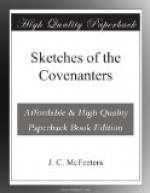“I,--------, do seriously and solemnly protest, in the presence of Almighty God, that in this Assembly, whereof I am a member, I will not maintain anything in matters of doctrine, but what I think in my conscience to be truth; or in point of discipline, but what I shall conceive to conduce most to the glory of God, and the good and peace of His Church.”
This oath was read every Monday morning to refresh memory and revive conscience. These men were working for the Kingdom of Christ, in the presence of the great white Throne; its brightness was flashing constantly upon their eyes.
THE WORK.
The work, to which the Assembly gave its attention, as specified by parliament, was “(1) A Confession of Faith, (2) A Catechism, (3) A Platform of Government, (4) A Directory for all Parts of Public Worship.”
The Confession of Faith: The first attempt was to revise the old creed of the Church of England. This was abandoned at the Fifteenth Article. A New Confession was then prepared having Thirty-three Articles, all of which are pillars of truth, every one ponderous, polished, and precious, revealing the quarry out of which they were hewn, and the skill of the workmen by whom they were chiselled. Henderson has been credited with the honor of preparing the first draft.
The Catechisms: The Shorter Catechism was prepared as a summary of Biblical instruction, appealing even by its literary construction and elegance to the heart and memory for lodgment. This golden chain is an ornament of grace that should be worn by every son and daughter of the Covenant. Rutherford seems to have been the original writer. The Larger Catechism is an expansion of the Shorter.
The Form of Church Government: The Divine right of Presbyterianism occasioned much discussion. The adoption of this principle was a deadly blow struck at the theory of Episcopacy—official ranks, tier above tier, in pyramidal form with the people beneath the pyramid. Equal authority of ministers in the administration of the Gospel of Christ, and equal authority of ministers and elders in administering government in the House of God—these were the great truths announced by the Assembly with clearness and solemnity, as the voice of God speaking in the holy Scriptures.
The Directory for Public Worship: This Directory superseded the Liturgy. The Liturgy had been condemned for “giving encouragement to an idle and unedifying ministry, who had chosen rather to confine themselves to forms, made to their hands, than to exert themselves in the gift of prayer, which our Saviour furnishes all those He calls to that office.” A warm discussion arose concerning the mode of receiving the Lord’s Supper. “The communicants orderly and gravely sitting round the table,” was the expression adopted. Successive tables received sanction from this expression.




